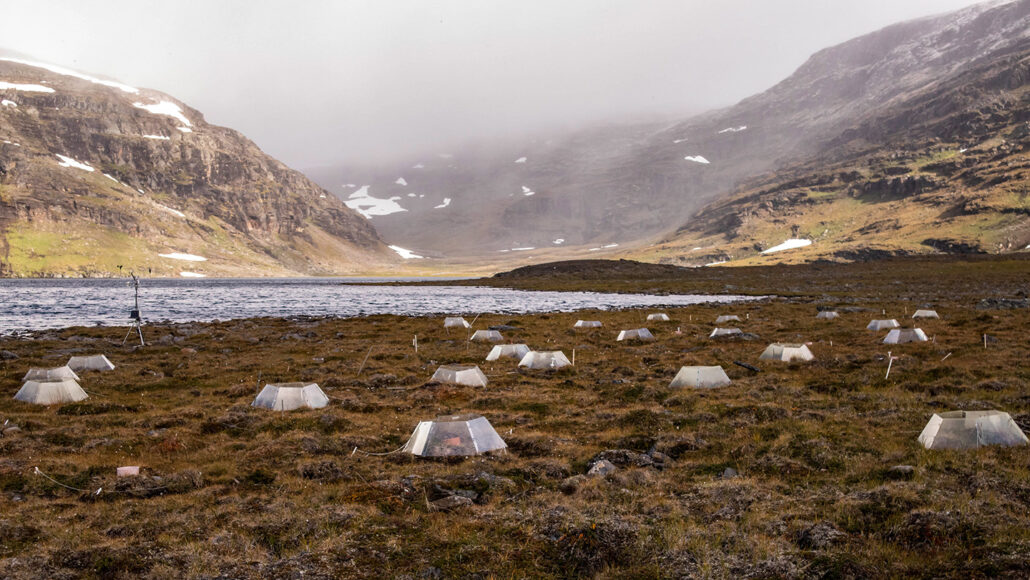Microbes in the Arctic may be releasing more climate-warming gases
A boost in the region’s CO2 output could drive even more climate change

Open-topped plastic chambers about 1 meter in diameter act as mini greenhouses, warming patches of tundra at this site in Latnjajaure, Sweden.
Sybryn Maes
Earth’s tundra is warming about four times faster than the rest of the planet. The rising fever in this Arctic ecosystem is boosting the production of carbon dioxide (CO2) by underground microbes, a new study suggests. If true, it could be setting up a feedback loop that leads to even more warming.
Small shrubs, grasses and lichen typically cover the tundra. Soils in these frigid lands also tend to be rich in organic carbon. Normally, the tundra is “a sleepy biome,” says Sybryn Maes. She’s an environmental scientist who works at Umeå University. That’s in Sweden. But warming will likely wake this sleeping giant. And that could prompt soil microbes to release more CO2, a potent greenhouse gas.
So far, this trend has been hard to confirm in the wild. Maes’ team decided to see if they could do it.
In all, some 70 scientists took measurements at 28 tundra sites across the globe. During the summer growing season, they placed clear, open-topped plastic chambers over patches of the ground. Each chamber was about a meter (39 inches) in diameter. These let in light and precipitation but blocked the wind. Summer temps inside the chambers were an average of 1.4 degrees Celsius (2.5 degrees Fahrenheit) warmer than at uncovered sites nearby.
The researchers also measured the soil microbes’ respiration — how much CO2 they spewed into the air. Then they compared these data to those from nearby uncovered patches of soil. Some data came from a single year. Elsewhere, teams collected data far longer — across up to 25 growing seasons.
That 1.4 degree Celsius increase boosted respiration — a lot. It rose by almost one-third across the covered sites. In all, the effects seemed fairly consistent with time, the researchers now conclude.
They shared their findings in May in Nature.
Some sites were more sensitive
The new data showed a lot of variability between sites. For instance, the CO₂ ramp-up was greatest where soils had the least nitrogen. Why? As soils warm, plants become more active. The plants need nitrogen, a nutrient, to grow. Soil microbes tend to harvest that nitrogen for them. And where these microbes were really active, hunting to find and extract that nitrogen, they also spewed more CO2 into the air.
These new findings provide the best evidence yet that warming boosts microbial activity and CO2 release, says Nicholas Bouskill. He’s an environmental microbiologist at Lawrence Berkeley National Laboratory. That’s in California. Previous studies looking at this had been much smaller. They also offered some contradictory findings (including one 2020 study by Bouskill’s team).
The long-term question, Bouskill says, is: “Will these areas become [CO2] sources?” Or will they largely continue to store carbon?
NASA estimates that permafrost in the Arctic stores 1,700 billion metric tons of carbon. Recent studies find that by the year 2100, defrosting tundra sites could spew between 22 billion and 524 billion metric tons of that stored carbon. How much it loses will depend on the rate of warming.
Given the expected increase in CO2 releases by microbes and their potential to further warm Earth’s climate, “you could say this is a doom scenario,” Maes says.
But, she adds, the study’s results do not mean the tundra’s overall release of carbon must skyrocket. In the end, other processes may counter this. For example, plants could ramp up their photosynthesis. Along the way, they’d take up and store more CO2. And these studies have not been looking at what happens outside the Arctic summer.
Including data on all that’s happening in the Arctic may help improve predictions of how the tundra is responding to a warming world. Those data may also be used to gauge how such Arctic impacts will affect the rest of Earth’s climate.







